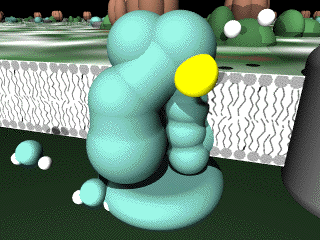
This is a series of three animated GIF files that helps you understand photosynthesis. This work was taken from the Virtual Cell. Be patient and allow these three animation files enough time to fully load onto your computer. Once loaded, each will cycle slowly and repeatedly.

Figure 1. This shows light hitting photosystem II (blue-green in color) and photosystem I (dark green color). Also shown are cytochrom b6/f (gray color) , and ATP-synthase (brown color).

Figure 2. This animation shows PSII absorbing light and consuming water (1 blue-green oxygen and 2 white hydrogens) to replace the electron holes produced by the photooxydation of chlorophyll a. The electrons are incorporated into chlorophyll and oxygen (blue-green) is produced as a waste product and the hydrogen ions are retained to increase the concentration of hydrogen ions inside the thylakoid. Later in the animation, an electron carrier (yellow) is shown to move on to cytochrome b6/f and carry with it two more hydrogen ions to be added to the growing number of hydrogens in the thylakoid space.
Figure 3. This animation shows the consumption of ADP (1 blue plus 2 red phosphates) and a phosphate (1 red) to produce ATP (1 bue and 3 reds). This synthesis is driven by the proton-motive force which is depicted as white spheres leaving through the ATP-synthase. (capable of rotational speeds from 0.5 to 4.0 revolutions per second)
(from http://www.bio.davidson.edu/courses/Bio111/Photosynth/PS.html)
ATP is the most important chemical energy source in all living cells. In mitochondria, bacteria, and chloroplasts the free energy stored in transmembrane electrochemical gradients is used to synthesize ATP from ADP and phosphate via the membrane-bound enzyme ATP synthase.
ATP synthase can also reverse itself and hydrolyze ATP to pump ions against an electrochemical gradient.
CBC News
Ancient bacteria shared photosynthesis genes
Last Updated Fri, 22 Nov 2002 16:36:38
TEMPE, ARIZ. - Photosynthesis didn't evolve in a straight path but by bacteria randomly swapping bits of genetic material, researchers say.
Photosynthesis is the vital chemical process that plants use to convert sunlight into chemical energy. Scientists think photosynthethic microbes added life-supporting energy and oxygen to the Earth.
Scientists understand some of the chemistry behind photosynthesis, but it has been difficult for them to trace how the process evolved. Now researchers in the U.S. have studied the genome of five diverse groups of photosynthetic bacteria that use light as an energy source. They mapped the relationships between the photosynthesis genes.
Arizona State University biochemistry Prof. Robert Blankenship led the study, which appears in Friday's issue of the journal Science.
Blankenship and his colleagues found photosynthesis didn't appear to evolve through a linear path that fits into a neat family tree.
Instead, the genetic analysis suggests these organisms used different pathways of evolution, resulting in a family tree that looks more like a bush.
The bacteria appeared to be using a process called horizontal gene transfer to swap genes for photosynthesis.
"This kind of evolution in bacteria is kind of like what happens at a junk dealer," said Blankenship in a release.
"Bits and pieces of whatever there is out in the yard get hauled back and welded together and made into this new thing. All these metabolic pathways get borrowed and bent a bit and changed."
Blankenship said the research may help scientists to understand how complex metabolic pathways evolved. It may help researchers to engineer new pathways into bacteria to design new drugs and other applications, he said.
Written by CBC News Online staff
from http://www.cbc.ca/stories/2002/11/22/photosyn021122We know that in our society things are in the junkyard because they were once useful things that had been discarded, and then some designer sees another useful reason to recycle them, possibly with some minor modification. How does this analogy apply to the four protein enzymes as illustrated above, PSI (dark green), PSII (blue-green), cytochrome (gray), and ATP-synthase (brown)? Guess that makes it official,
the "theory of evolution" is "JUNKYARD SCIENCE" !But one just has to ask, why were these "things" in the junkyard?
Why did these protein enzymes exist?
What was their purpose and function as a isolated enzyme?
Doesn't this all require a designer to know that there would be a useful function for each of these separate enzymes acting together in such a wonderfully integrated system such as photosynthesis?
return to Life from Dead Stuff !